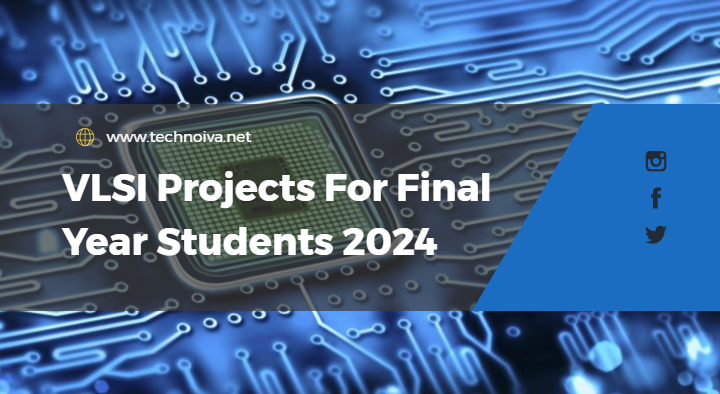Very Large-Scale Integration (VLSI) is an essential technique in the rapidly developing fields of electronics and computing. It allows for the production of complex integrated circuits, which in turn power our modern electronic devices. As final-year students preparing for your career, VLSI projects give an exceptional opportunity to learn about semiconductor design, digital systems, and breakthrough technologies.
As VLSI processes and tools are always being improved, there is a wide range of project possibilities that present various problems and opportunities. There is a VLSI project for final year students, whether they are interested in low-power design, digital signal processing, or new technology like quantum computing.
This blog post we explores VLSI project ideas for final year ece a well-selected collection of vlsi based projects like ieee vlsi projects, m tech vlsi projects, vlsi mini projects, With each project proposal, we hope to help you develop as engineers and pioneers in the field of VLSI design while also testing your technical abilities. You will be well-prepared for the ever-changing semiconductor industry with the hands-on experience you gain from these projects, which cover everything from brainstorming to engineering.
101+ VLSI Projects For Final Year Students 2024
Here are some VLSI projects ideas suitable for final year students:
- Design of a Low-Power Processor: Create a power-efficient microprocessor with minimal power consumption and optimal performance by utilizing very large scale integration (VLSI) techniques.
- Implementation of Digital Signal Processing (DSP) Algorithms: Apply digital signal processing algorithms to an FPGA or ASIC platform, for example, Fast Fourier Transform, Finite Impulse Response, or Infinite Impulse Response filters.
- Design of a Neural Network Accelerator: The goal of this project is to design and develop a hardware accelerator for neural networks, with the intention of targeting applications such as image recognition and natural language processing.
- High-Speed Serial Communication Interface: VLSI techniques should be utilized in order to design a high-speed serial communication interface, such as PCIe (Peripheral Component Interconnect Express) or USB (Universal Serial Bus).
- Custom Memory Controller Design: Design a custom memory controller for specific memory technologies like DDR (Double Data Rate) SDRAM (Synchronous Dynamic Random Access Memory) or HBM (High Bandwidth Memory).
- Smart Sensor Interface: Design a smart sensor interface chip integrating analog front-end circuitry with digital signal processing for applications like IoT (Internet of Things) or wearable devices.
- ASIC Implementation of Cryptographic Algorithms: Implement cryptographic algorithms such as AES (Advanced Encryption Standard) or SHA (Secure Hash Algorithm) in ASIC for secure communication systems.
- Mixed-Signal IC Design: Design a mixed-signal integrated circuit combining analog and digital circuitry for applications like data converters (ADCs/DACs), voltage regulators, or audio amplifiers.
- Energy Harvesting System: Design an energy harvesting system using VLSI techniques to capture and convert ambient energy sources like solar, thermal, or kinetic energy into electrical energy for low-power applications.
- Design of a Reconfigurable Computing Platform: Develop a reconfigurable computing platform using FPGA or ASIC technology, allowing users to dynamically reconfigure hardware resources to adapt to different application requirements.
- Analog-to-Digital Converter (ADC) Design: Design and implement a high-resolution, low-power ADC for applications such as sensor interfaces or data acquisition systems.
- Clock Distribution Network Optimization: Optimize the clock distribution network in an ASIC or FPGA design to minimize skew and jitter while maximizing frequency and reliability.
- Fault-Tolerant VLSI Systems: Design a fault-tolerant VLSI system capable of detecting and recovering from hardware faults using redundancy and error correction techniques.
- Automotive Electronics: Design VLSI circuits for automotive applications such as driver assistance systems, infotainment systems, or engine control units, focusing on reliability and safety.
- Wireless Communication Transceiver Design: Design and implement a wireless communication transceiver for standards like Bluetooth, Wi-Fi, or LTE, optimizing for power efficiency and data rate.
- Sensor Fusion System: Develop a sensor fusion system integrating data from multiple sensors (e.g., accelerometers, gyroscopes, magnetometers) using VLSI techniques for applications like motion tracking or navigation.
- Low-Power Audio Codec Design: Design a low-power audio codec for applications such as mobile devices, IoT devices, or wearable electronics, focusing on high-quality audio reproduction and power efficiency.
- Hardware Security Module: Design a hardware security module (HSM) incorporating cryptographic algorithms and secure key storage for applications such as secure boot, secure communication, or digital rights management.
- Custom Digital Filter Design: Design and implement custom digital filters (e.g., IIR, FIR, or adaptive filters) for signal processing applications such as audio processing, image processing, or biomedical signal processing.
- VLSI Design for Quantum Computing: Explore VLSI design techniques for quantum computing architectures such as superconducting qubits, trapped ions, or topological qubits, focusing on scalability and error correction.
- Biomedical Implantable Devices: Design VLSI circuits for biomedical implantable devices such as pacemakers, neural stimulators, or drug delivery systems, focusing on miniaturization, power efficiency, and biocompatibility.
- High-Speed Memory Interface Design: Design and optimize high-speed memory interfaces (e.g., DDR, HBM, GDDR) for high-performance computing applications such as GPUs, FPGAs, or data center servers.
- Analog Front-End Design for Sensing Applications: Design analog front-end circuits for sensing applications such as temperature sensing, pressure sensing, or gas sensing, optimizing for sensitivity, accuracy, and power efficiency.
- Fault Diagnosis and Testing in VLSI Circuits: Develop techniques for fault diagnosis and testing in VLSI circuits, focusing on identifying and isolating faults to improve manufacturing yield and reliability.
- Energy-Efficient Microcontroller Design: Design a microcontroller with energy-efficient features for battery-powered applications such as IoT devices, wearable electronics, or remote sensors, optimizing for low-power operation and sleep modes.
- Hardware Accelerator for Machine Learning Inference: Design a hardware accelerator for machine learning inference tasks such as image recognition, speech recognition, or natural language processing, optimizing for performance and energy efficiency.
- Optical Communication Transceiver Design: Design and implement an optical communication transceiver for high-speed data transmission in data center networks or long-haul communication systems, focusing on power efficiency and signal integrity.
- Smart Grid Components: Design VLSI components for smart grid applications such as smart meters, power line communication (PLC) modems, or grid monitoring systems, focusing on reliability, security, and interoperability.
- Adaptive Antenna Array Processing: Design VLSI circuits for adaptive antenna array processing techniques such as beamforming, interference suppression, or spatial multiplexing, for applications such as wireless communication or radar systems.
- Low-Power RF Transceiver Design: Design a low-power RF transceiver for wireless communication applications such as IoT networks, wearable devices, or wireless sensor networks, optimizing for power efficiency and range.
- Integrated Power Management Unit: Design an integrated power management unit (PMU) incorporating voltage regulators, power switches, and battery management features for portable devices or IoT applications.
- Secure Hardware Enclave: Design a secure hardware enclave for storing sensitive data and executing trusted computing tasks in applications such as secure boot, digital rights management, or cryptographic key management.
- Ultra-Low-Power Sensor Node: Design an ultra-low-power sensor node for wireless sensor networks (WSNs) or IoT applications, optimizing for energy harvesting, sleep modes, and long-term operation on battery power.
- Custom Instruction Set Architecture (ISA) Design: Design and implement a custom instruction set architecture (ISA) tailored for specific application domains such as digital signal processing (DSP), machine learning, or cryptography.
- High-Speed Interconnect Design: Design and optimize high-speed interconnects (e.g., SerDes, high-speed buses) for on-chip or off-chip communication in multi-core processors, FPGAs, or system-on-chip (SoC) designs.
- Embedded FPGA (eFPGA) Integration: Integrate embedded FPGA (eFPGA) IP blocks into ASIC designs to provide programmable logic fabric for on-the-fly customization and acceleration of specific algorithms or functions.
- Hardware Trojan Detection and Prevention: Develop techniques for detecting and preventing hardware Trojans in VLSI designs, focusing on security verification, side-channel analysis, and design obfuscation.
- Energy-Efficient Neural Network Accelerator: Design a specialized neural network accelerator for low-power edge computing devices, optimizing for energy efficiency and performance in inference tasks.
- Custom Memory Hierarchy Design: Design a custom memory hierarchy incorporating cache memories, scratchpad memories, and memory controllers tailored for specific application workloads and access patterns.
- RFID Tag Design: Design and implement an RFID tag chip for applications such as asset tracking, inventory management, or access control, optimizing for low-cost, low-power operation, and long-range communication.
- Secure Processor Core Design: Design a secure processor core with built-in hardware security features such as secure boot, trusted execution environment (TEE), and side-channel attack countermeasures.
- Low-Power Wireless Transceiver Design: Design a low-power wireless transceiver for short-range communication protocols such as Zigbee, Bluetooth Low Energy (BLE), or LoRaWAN, optimizing for energy efficiency and range.
- Energy Harvesting Power Management System: Design a power management system for energy harvesting applications, integrating energy storage devices, power conditioning circuits, and maximum power point tracking (MPPT) algorithms.
- Custom Digital Signal Processor (DSP) Core: Design and implement a custom DSP core optimized for specific signal processing algorithms such as audio processing, image processing, or telecommunications.
- Silicon Photonics Integration: Explore the integration of silicon photonics components (e.g., modulators, detectors, waveguides) into VLSI designs for high-speed, low-power optical communication systems.
- Analog-Mixed Signal System-on-Chip (AMS-SoC): Design a complex system-on-chip (SoC) integrating analog and mixed-signal circuits with digital processing cores for applications such as multimedia processing or wireless communication.
- Secure Element for IoT Devices: Design a secure element chip for IoT devices, providing hardware-based security features such as secure storage, cryptographic acceleration, and secure boot functionality.
- High-Speed Serializer/Deserializer (SerDes): Design and optimize high-speed SerDes IP cores for data communication rates exceeding several gigabits per second (Gbps) in applications such as data centers or high-performance computing.
- Automated Design Space Exploration: Develop algorithms and tools for automated design space exploration in VLSI design, optimizing for performance, power, area, and other design constraints across a range of architectural choices.
- Ultra-Low-Power Microcontroller for Wearables: Design an ultra-low-power microcontroller optimized for wearable devices, incorporating features such as low-power wake-up timers, efficient sleep modes, and sensor fusion capabilities.
Read Also: The Best Study Abroad Tips Will Be Very Helpful For You
Here are some VLSI projects ideas categorized by their application areas to get you started:
General Purpose Processors:
- Single/Multi-cycle processor core: Design the core functionality of a processor, defining how it fetches, decodes, and executes instructions.
- Custom ISA: Create a unique instruction set tailored for a specific application’s needs.
- Pipelined processor: Enhance performance by overlapping instruction execution stages.
- Cache memory hierarchy: Implement different levels of memory to improve data access speed.
- Branch prediction unit: Predict future execution branches to reduce processor stalls.
Memory Design:
- SRAM cell: Design the basic building block of static memory, responsible for storing data.
- Content-addressable memory (CAM): Search memory based on data content, not just location.
- Error-correcting code (ECC): Implement mechanisms to detect and correct errors in memory data.
- Multi-ported memory: Allow simultaneous data access from multiple processing units.
- High-speed memory interface: Design efficient communication protocols for memory access.
Communication and Networking:
- Network-on-chip (NoC): Create a network within the chip to enable communication between processing cores.
- Peripheral interface controller (PIC): Bridge communication between the processor and external devices.
- Communication protocol: Implement protocols like UART or SPI for data exchange.
- High-speed serial interface: Design an interface for fast data transfer over long distances.
- Network interface controller (NIC): Connect the chip to a larger network for broader communication.
Security:
- Hardware RNG: Generate unpredictable random numbers crucial for cryptography.
- Cryptographic algorithm (e.g., AES, RSA): Implement encryption and decryption algorithms for secure communication.
- Secure boot: Ensure the system boots only with authorized software.
- Hardware security module (HSM): Dedicate a secure chip for handling sensitive data.
- Tamper-resistant design: Protect the chip from unauthorized modifications.
Signal Processing:
- Digital filter: Remove unwanted frequencies or enhance desired ones in a signal.
- Fast Fourier transform (FFT): Analyze the frequency content of a signal efficiently.
- Hardware accelerator: Implement specific algorithms in hardware for faster processing.
- Analog-to-digital converter (ADC): Convert analog signals (e.g., voltage) into digital data.
- Digital-to-analog converter (DAC): Convert digital data back into analog signals.
Embedded Systems:
- Complete embedded system: Design a system performing a specific task (e.g., temperature sensor) with hardware and software.
- Low-power design: Optimize the system for minimal power consumption.
- Real-time operating system (RTOS): Manage tasks and resources in an embedded system with strict timing constraints.
- Low-power communication protocol: Design communication protocols with minimal power usage.
- Security framework: Implement security measures to protect the embedded system.
Machine Learning:
- Hardware accelerator for CNNs/RNNs: Design specialized hardware for faster execution of specific machine learning algorithms.
- Machine learning on FPGA: Implement machine learning algorithms on a Field-Programmable Gate Array (FPGA).
- Low-power machine learning accelerator: Design an accelerator with both performance and power efficiency in mind.
- Hardware-based quantization: Reduce the precision of data representation for efficient machine learning implementation.
Conclusion
Very Large-Scale Integration (VLSI) gives final-year students many project options. Students can improve their technical skills, gain practical experience, and prepare for successful semiconductor industry employment by working on these creative projects. Whether creating low-power processors, implementing digital signal processing algorithms, or exploring new technologies like quantum computing, VLSI project exploration will inspire and empower students to become engineers and innovators. Join this exciting VLSI project development adventure and embrace the challenges, take the opportunities, and let your creativity soar.







